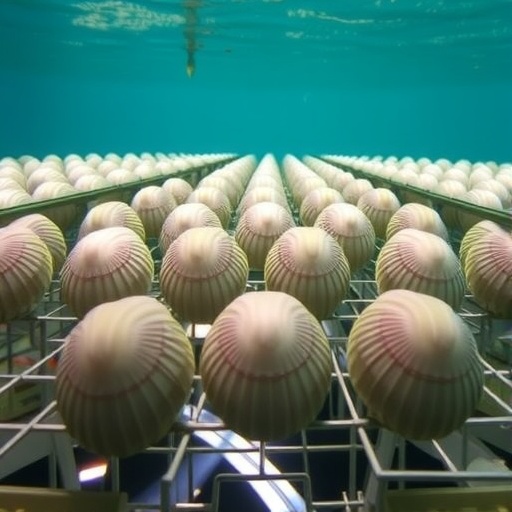In the evolving landscape of marine aquaculture, the cultivation of Atlantic sea scallops in the Gulf of Maine is emerging as a promising frontier, driven by innovative research adapting proven Japanese farming methodologies to local conditions. While oyster farming remains the dominant aquaculture activity in the region, a team of researchers at the University of Maine has undertaken a comprehensive techno-economic evaluation of two prevalent scallop farming techniques—lantern net and ear-hanging—to spark growth in this sector and support Maine’s blue economy.
The impetus for this research stems from a four-year comparative study published in early 2025, which not only assessed the biological productivity of these scallop farming styles but also delved deeply into their economic feasibility over time. Led by marine sciences professor Damian Brady, alongside postdoctoral researcher Chris Noren, the project advanced beyond biological metrics to encompass labor, lease costs, equipment expenses, and market potential. This culminated in the creation of an interactive digital tool specifically designed to help new and prospective scallop farmers evaluate investment options considering location, operational timeframes, and budgetary constraints.
Historically, the lantern net technique has been favored for its relatively straightforward setup and lower initial costs. This method involves suspending tiered circular nets vertically in the water column, providing a compact environment for scallops to grow. However, researchers recognize that these confined conditions often result in overcrowding, which can limit access to nutrients and space. While earlier assumptions credited lantern nets with greater cost-efficiency, the latest findings suggest that their advantage holds primarily for scallops harvested before three years of growth.
Conversely, the ear-hanging method—rooted firmly in traditional Japanese aquaculture—requires drilling holes into the scallops’ “ears” or hinges, through which they are pinned and grown individually along vertical lines. Though this process demands higher upfront labor and more specialized equipment, its design permits enhanced growth rates by reducing competition for food and space. Importantly, the study revealed that when scallop life cycles extend beyond three years, ear-hanging surpasses lantern nets in economic performance, chiefly due to reduced ongoing labor costs and lower lease size requirements derived from its spatial efficiency.
From a technical standpoint, the research team measured scallop growth through two key biometric parameters: the overall shell height in millimeters and the weight of the adductor muscle in grams. These metrics are particularly relevant to market dynamics, as the U.S. commercial sale focuses predominantly on the adductor muscle—the tender portion that commands premium prices. Larger, heavier adductor muscles correlate with higher market values, making growth optimization a critical consideration in cultivation technology selection. Ear-hanging, it turns out, consistently produced scallops with more substantial adductor muscles, a decisive factor in the technique’s long-term profitability.
The implications for lease economies cannot be understated. Since ear-hanging requires less horizontal space compared to the bulkier lantern nets, farmers can operate on smaller lease areas, cutting down tenant costs on heavily regulated coastal waters. This spatial efficiency, coupled with decreasing labor demands after the initial setup phase, paints a compelling picture for scalability within the region’s existing aquaculture zones and limited waterfront infrastructure.
A noteworthy aspect of this research is its integration of advanced automation technologies and cooperative operational models inspired by Japanese scallop farms. Automated drilling and pinning machinery mitigate the traditionally labor-intensive ear-hanging start-up, while shared ownership arrangements distribute the cost and expertise required for machinery investment and farm management. Such innovations have the potential to reduce financial barriers for entry and enable more robust community participation in aquaculture ventures.
Beyond economic parameters, the study underscores the significance of maintaining accessible working waterfronts. Researchers emphasize that certain post-cultivation tasks, such as sorting, harvesting preparation, and equipment maintenance, benefit greatly from shore-based facilities. These fixed locations reduce weather-related delays and enable smaller farms to operate more flexibly, critical factors in the viability of an emerging aquaculture industry facing seasonal and environmental constraints.
Farmers and stakeholders can access the user-friendly online decision-support application developed by Brady and Noren, which synthesizes their data into a practical planning resource. The application allows for side-by-side comparison of cost projections, growth rates, and operational considerations tailored to specific scenarios, thereby empowering informed decision-making and personalized risk assessment.
Despite ear-hanging’s higher initial investment, the cumulative advantages demonstrated through the study’s four-year projection forecast greater net profitability, especially for operators planning multi-year ventures. The optimal harvesting window appears to be between 3.75 and 4 years, at which point scallops from either farming method reach ideal maturity. This insight challenges prior industry norms that favored earlier harvesting cycles for quicker turnover and suggests that patient, long-term management may substantially elevate economic returns.
The transformation of scallop aquaculture in Maine, as illuminated by this research, represents a convergence of biological insight, economic analysis, and technological adaptation. By leveraging traditional knowledge from Japan and rigorously quantifying the financial outcomes, the University of Maine team provides a roadmap for building a sustainable and growing industry that contributes to local economies while preserving environmental and cultural values.
Ultimately, this study not only advances scientific understanding of scallop growth dynamics in temperate North Atlantic waters but also lays the groundwork for economic resilience and innovation. As global demand for sustainable seafood intensifies, scalable mariculture solutions such as those demonstrated here will be vital. The integration of efficient farming techniques, cooperative frameworks, and community resources positions the Gulf of Maine as a potential leader in scallop aquaculture, expanding beyond oyster dominance and enriching coastal livelihoods for decades to come.
Subject of Research: Not applicable
Article Title: Techno-economic assessment of ear-hanging and lantern net grow-out techniques in Atlantic Sea scallop, Placopecten magellanicus, aquaculture in the Gulf of Maine
News Publication Date: 31-May-2025
Web References:
- University of Maine Research Blog on Scallop Farming
- Interactive Scallop Farm Application
- Journal Article in Aquaculture
References: Aquaculture, 31-May-2025, Data/statistical analysis by University of Maine researchers Damian Brady and Chris Noren
Image Credits: Not specified
Keywords: Mariculture, Mollusks, Marine biology, Economics




